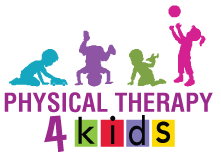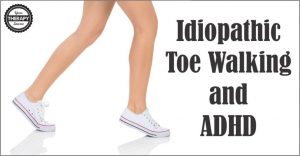Most children learn to walk between 12-15 months of age with their feet flat on the ground. Some children who are first learning to walk may walk up on their toes or on the balls of their feet. This typically disappears within 3-6 months of regular walking. Habitual toe walking occurs with children who continue to toe walk beyond the toddler years (after age 2). By age 3, there should not be any residual toe walking. Some parents think it is “cute,” but if it persists, it needs to be watched and addressed. Left untreated, children can end up with tight leg muscles, balance and coordination difficulties and walking problems. Early treatment by a Pediatric Physical Therapist can reduce and prevent toe walking.
At Physical Therapy 4 Kids, toe walking is one of the more frequent diagnoses treated here with tremendous success.
Causes of Toe Walking:
- Idiopathic/Habitual Toe Walking – persistence of toe walking for no known reason
- Shortened Heelcords (Achilles tendons) – this is the tendon that connects the lower leg muscle to the heel bone, preventing the heel from touching the ground
- Cerebral Palsy – increased tone due to a neurological condition can cause an impairment of the child’s muscle tone or posture
- Muscular Dystrophy – with genetic conditions like muscular dystrophy, muscle fibers are prone to damage and weaken over a period of time causing the child to rise up on their toes.
- Autism – children diagnosed with autism may demonstrate toe walking
- Sensory Processing Disorders – children may have sensory issues and do not like the feeling of their feet touching the surface so they rise up on their toes to avoid their heels touching an uncomfortable surface. They also may not like the sensation of socks, shoes or bare feet.
- Vestibular System Dysfunction – the brain may be giving the child a wrong signal on where their body is in space or how to move properly
Signs of Toe Walking
- Walks up on tip toes
- Able to stand on flat feet when concentrating but then rises up on toes when they start to move
- Walks with knees straight
- Balance sup on their toes when standing still
- Able to keep up with other children even though they are up on their toes
- May have a family history of toe walking
Complications of Toe Walking
- Walking difficulties
- Increased risk of falling
- Balance and coordination difficulties
- Pain in the hips, knees or ankles
- Difficulty climbing up or down stairs
- Decreased core strength and postural issues
- Social stigma
Treatment for Toe Walking
Early Referral from the Pediatrician for Physical Therapy
- Specific stretching and strengthening exercises
- Range of motion exercises
- Balance and coordination training
- Walking training on different surfaces
- Walking on their heels
- Sensory stimulation program to desensitize feet
- Braces, splints or inserts to keep heels flat on floor
- Specific shoe recommendations or heel lifts or wedges
At Physical Therapy 4 Kids, we make our treatment sessions FUN!!! We use imagination and creativity along with our therapeutic skills to put an end to Toe Walking.
DON’T WAIT!
Call 914-421-9392
Evaluations scheduled within 24-28 hours

